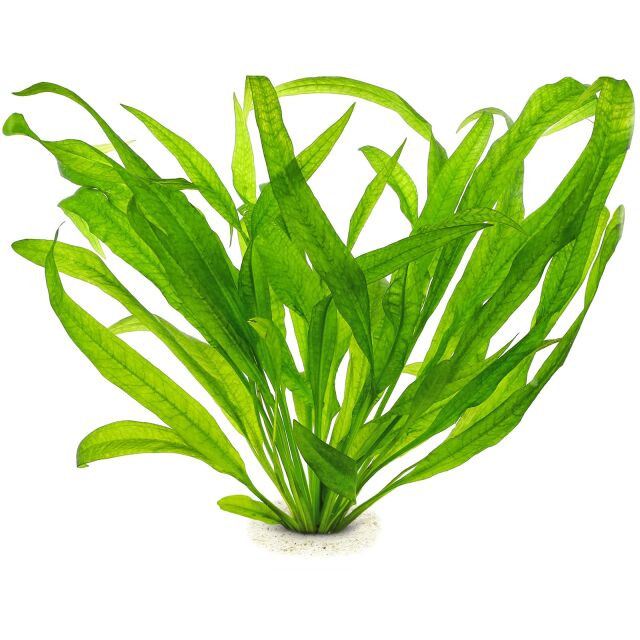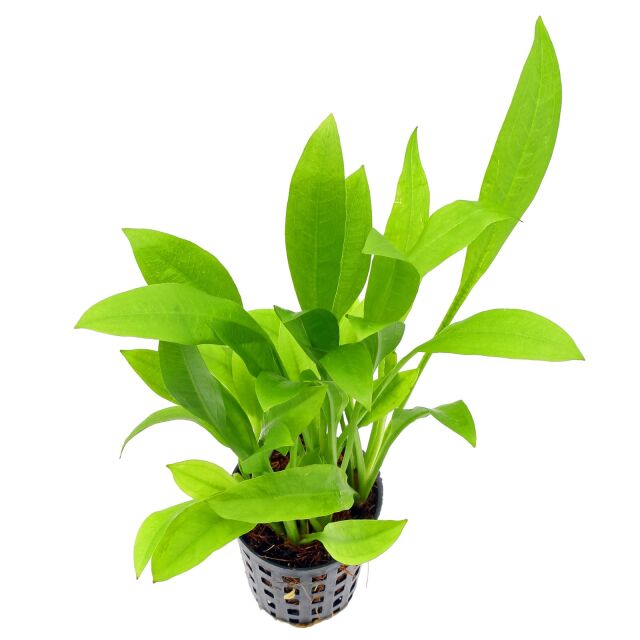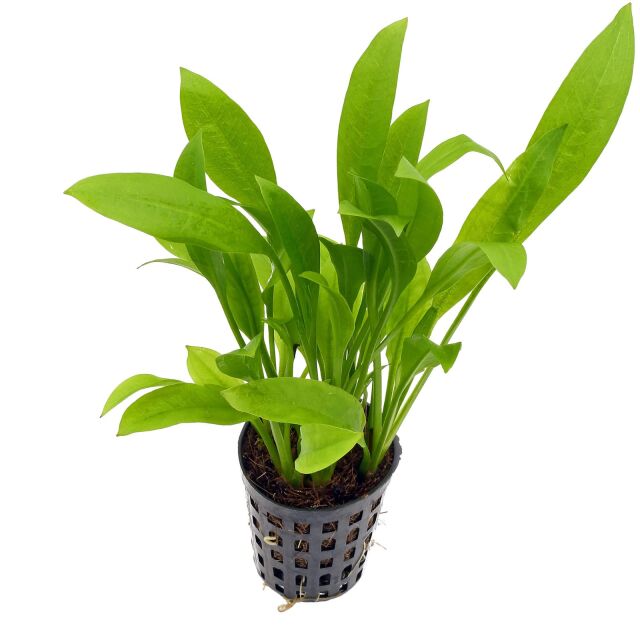Amazon Sword




Echinodorus grisebachii 'Amazonicus'
Amazon Sword
- Impressive solitary plant in large aquaria
- Narrow leaf shape
- Undemanding
- Suitable for discus tanks
Item question
We’re here for you!
Please enter your question and e-mail and we’ll contact you as soon as possible. It usually takes us up to 24 hours during business days to respond.
Thank you for your question!
Thank you, we’ll get in touch!
Close window
You already sent us a question.
Please wait a few minutes
Description
The Amazon swordplant is a long-known, time-tested aquarium plant from tropical South America. For a long time it was considered its own species (Echinodorus amazonicus), but it is a form of Echinodorus grisebachii. It differs from Echinodorus grisebachii 'Bleherae' by having distinctly narrower leaves. Like the other forms of E. grisebachii, this sword plant develops a magnificent, broad rosette of countless medium green leaves. Young, emerging leaves often have dark brown veining and later turn green. Fully developed leaf rosettes can grow over 40 cm high and wide, so the space requirement in the aquarium must be considered.
This Echinodorus wild type has only low requirements, but medium light intensity and a nutrient-rich substrate are recommended. Medium-hard water is well tolerated, temperatures can be between 18 and 30 °C, about 22 to 26 °C is optimal. Remove the oldest, unsightly leaves, but you can also remove many leaves if the plant has taken up too much space. However, the plant looks best as a free-standing specimen with many leaves. Like many other Echinodorus, the Amazon sword reproduces by adventitious plants on inflorescences. These develop not only in the emersed form but also on the submerged plant in the aquarium.
Echinodorus grisebachii 'Amazonicus' looks beautiful as a solitary in large, over 40 cm high tanks where e.g. discus fish or angelfish are kept. The latter often lay their eggs on the leaves.
Echinodorus grisebachii 'Amazonicus', the narrow-leaved Amazon sword, is widely known as E. amazonicus. It belongs to the species Echinodorus grisebachii, widely spread in the American tropics and known for its many varieties. E. grisebachii 'Bleherae' and E. grisebachii 'Parviflorus' are also counted amongst this species.
First, this plant was brought onto the market in 1938, back then still under the erronous name "E. brevipedicellatus" (a synonym of Echinodorus longipetalus). It was long carried under that name. Only in 1970, Karel Rataj described it as a new species (E. amazonicus). Its origins are reported to lie in the Brazilian Amazon depression (Rondônia and Pará), where it was found growing submersed in 50 to 100 cm deep stagnant to slow-flowing water.
Usually, forms of E. grisebachii that are quite similar to E. (read more)
| Common names | Amazon Sword |
| Synonyms | Echinodorus amazonicus Rataj |
| Misapplied names | Echinodorus brevipedicellatus |
| Complete botanical name | Echinódorus grisebáchii Small |
| Family | Alismataceae |
| Genus | Echinodorus |
| Difficulty | easy |
| Usage | Background |
| Growth | fast |
| Temperature tolerance | 18 - 30°C |
| General hardness | 0 - 30°dGH |
| Propagation | Proliferating inflorescences, Rhizomteilung |
| Can grow emersed? | yes |
| Source | Flowgrow |
| Common names |
| Amazon Sword |
| Synonyms |
| Echinodorus amazonicus Rataj |
| Misapplied names |
| Echinodorus brevipedicellatus |
| Complete botanical name |
| Echinódorus grisebáchii Small |
| Family |
| Alismataceae |
| Genus |
| Echinodorus |
| Difficulty |
| easy |
| Usage |
| Background |
| Growth |
| fast |
| Temperature tolerance |
| 18 - 30°C |
| General hardness |
| 0 - 30°dGH |
| Propagation |
| Proliferating inflorescences, Rhizomteilung |
| Can grow emersed? |
| yes |
| Source |
| Flowgrow |
General information
| Item no. |
|
| EAN | 4001615001617 |
| Weight | 0,10 kg |
| Shipping weight | 0,10 kg |
Customers ask customers
You have questions about this product? Ask other customer or our support team about this product!
Customer reviews
2 Reviews
| 5 Stars(2) |
|
| 4 Stars(0) |
|
| 3 Stars(0) |
|
| 2 Stars(0) |
|
| 1 Star(0) |
|

Out of the packet the leaves were quite tall but very narrow. 3 weeks later I finally understood how huge this plant will grow to be! The plant seems to grow wide first, then tall. (read more)